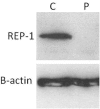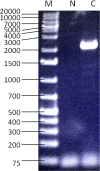Molecular genetic diagnostic techniques in choroideremia
- PMID: 24791138
- PMCID: PMC4000712
Molecular genetic diagnostic techniques in choroideremia
Abstract
Purpose: To optimize and streamline molecular genetics techniques in diagnosing choroideremia (CHM).
Methods: PCR primers were designed for exons 3, 4, 5, 6, 7, 8, 9, 10, 11, 12, and 15 of the CHM gene. Each PCR protocol was optimized so that all exons could be amplified with the same component ratio and PCR conditions. Sense and antisense primers were tested for their ability to be used as sequencing primers. Fibroblast cells were cultured, and an immunoblot analysis was performed to detect the presence or absence of Rab escort protein 1 (REP-1) in a suspected CHM patient sample when no mutation was detected with sequencing. Multiplex ligation-dependent probe amplification (MLPA) of the CHM gene was performed and used to detect deletions and duplications in affected males and female carriers. RNA analysis using cDNA was used to detect the presence or absence of the CHM transcript and to search for splice defects.
Results: The newly designed PCR primers allow for more efficient PCR preparation and sequencing to detect point mutations in affected males and female carriers. Immunoblot successfully detects the absence of REP-1 in a CHM patient. MLPA identifies deletions and duplications spanning multiple exons in the CHM gene. RNA analysis aids in detecting splice variants.
Conclusions: The development of new molecular biology techniques and ongoing optimization of existing methods allows for an improved integrated approach to confirm CHM diagnosis and carrier status in consideration of patient family history and available patient sample materials. CHM can be confirmed with an immunoblot assay. To detect the molecular cause of CHM, an examination of the genomic DNA or the mRNA must be performed. Presymptomatic carriers with no identifiable fundus signs can be identified only through molecular analysis of genomic DNA or through quantitative assays.
Figures




Similar articles
-
Copy number variant analysis in CHM to detect duplications underlying choroideremia.Ophthalmic Genet. 2013 Dec;34(4):229-33. doi: 10.3109/13816810.2012.752016. Epub 2012 Dec 28. Ophthalmic Genet. 2013. PMID: 23273018
-
A practical diagnostic test for choroideremia.Ophthalmology. 1998 Sep;105(9):1637-40. doi: 10.1016/S0161-6420(98)99031-5. Ophthalmology. 1998. PMID: 9754170
-
Rep1 copy number variation is an important genetic cause of choroideremia in Chinese patients.Exp Eye Res. 2017 Nov;164:64-73. doi: 10.1016/j.exer.2017.07.016. Epub 2017 Jul 31. Exp Eye Res. 2017. PMID: 28774736
-
CHM mutation spectrum and disease: An update at the time of human therapeutic trials.Hum Mutat. 2021 Apr;42(4):323-341. doi: 10.1002/humu.24174. Epub 2021 Feb 19. Hum Mutat. 2021. PMID: 33538369 Review.
-
Molecular basis of choroideremia (CHM): mutations involving the Rab escort protein-1 (REP-1) gene.Hum Mutat. 1997;9(2):110-7. doi: 10.1002/(SICI)1098-1004(1997)9:2<110::AID-HUMU2>3.0.CO;2-D. Hum Mutat. 1997. PMID: 9067750 Review.
Cited by
-
Update on Viral Gene Therapy Clinical Trials for Retinal Diseases.Hum Gene Ther. 2022 Sep;33(17-18):865-878. doi: 10.1089/hum.2022.159. Hum Gene Ther. 2022. PMID: 36074935 Free PMC article. Review.
-
Choroideremia: Update On Clinical Features And Emerging Treatments.Clin Ophthalmol. 2019 Nov 18;13:2225-2231. doi: 10.2147/OPTH.S195564. eCollection 2019. Clin Ophthalmol. 2019. PMID: 31819346 Free PMC article. Review.
-
A novel SVA retrotransposon insertion in the CHM gene results in loss of REP-1 causing choroideremia.Ophthalmic Genet. 2020 Aug;41(4):341-344. doi: 10.1080/13816810.2020.1768557. Epub 2020 May 22. Ophthalmic Genet. 2020. PMID: 32441177 Free PMC article.
-
Genetic analysis and clinical phenotype of two Indian families with X-linked choroideremia.Indian J Ophthalmol. 2016 Dec;64(12):924-929. doi: 10.4103/0301-4738.198866. Indian J Ophthalmol. 2016. PMID: 28112135 Free PMC article.
-
Novel CHM mutations identified in Chinese families with Choroideremia.Sci Rep. 2016 Oct 14;6:35360. doi: 10.1038/srep35360. Sci Rep. 2016. PMID: 27739455 Free PMC article.
References
-
- MacDonald IM, Sereda C, McTaggart K, Mah D. Choroideremia gene testing. Expert Rev Mol Diagn. 2004;4:478–84. - PubMed
-
- Seabra MC, Brown MS, Goldstein JL. Retinal degeneration in choroideremia: Deficiency of rab geranylgeranyl transferase. Science. 1993;259:377–81. - PubMed
-
- Seabra MC, Ho YK, Anant JS. Deficient geranylgeranylation of Ram/Rab27 in choroideremia. J Biol Chem. 1995;270:24420–7. - PubMed
-
- Tolmachova T, Anders R, Abrink M, Bugeon L, Dallman MJ, Futter CE, Ramalho JS, Tonagel F, Tanimoto N, Seeliger MW, Huxley C, Seabra MC. Independent degeneration of photoreceptors and retinal pigment epithelium in conditional knockout mouse models of choroideremia. J Clin Invest. 2006;116:386–94. - PMC - PubMed
-
- van Bokhoven H, van den Hurk JA, Bogerd L, Philippe C, Gilgenkrantz S, de Jong P, Ropers HH, Cremers FP. Cloning and characterization of the human choroideremia gene. Hum Mol Genet. 1994;3:1041–6. - PubMed
Publication types
MeSH terms
Substances
Grants and funding
LinkOut - more resources
Full Text Sources
Research Materials

